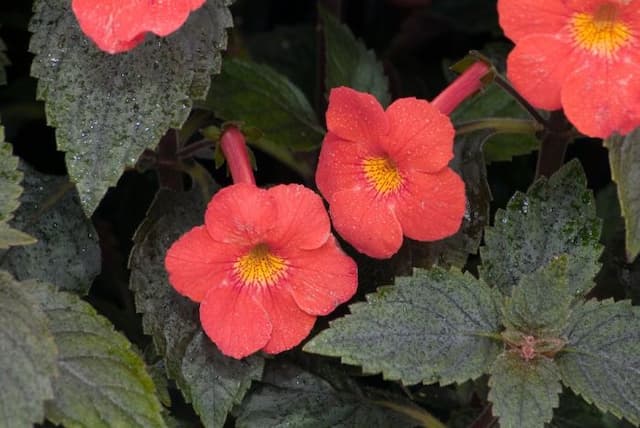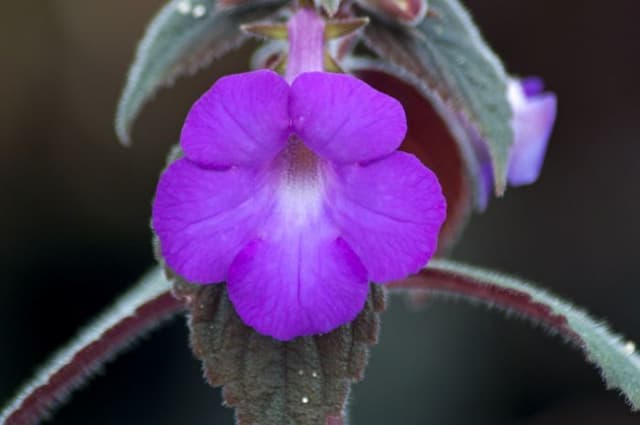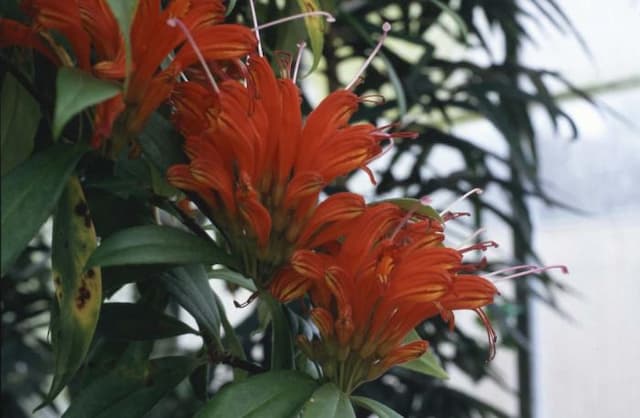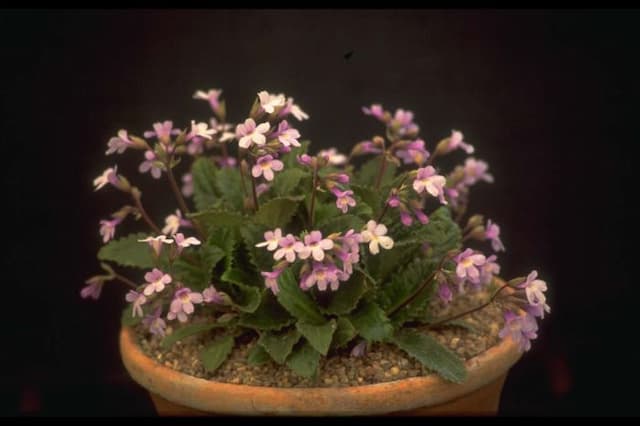Cape Primrose Streptocarpus 'Crystal Wonder'

ABOUT
The Streptocarpus 'Crystal Wonder', commonly known as Cape Primrose, is a striking plant with a lush rosette of dark green leaves that often have a velvety or slightly textured surface. The foliage forms a backdrop for the plant's main attraction, which are its beautiful flowers. These blossoms are typically trumpet-shaped and come in a vibrant array of colors, often featuring intricate patterns or contrasting color throats. The 'Crystal Wonder' variety may exhibit unique floral colors such as purplish hues with white and yellow markings, or a crystalline dusting that adds to its enchanting look. The flowers bloom profusely under the right conditions, creating a remarkable display that seems to float above the foliage on slender, yet sturdy stalks. The overall appearance of Cape Primrose is delicate and ornamental, making it a popular choice for indoor plant enthusiasts who appreciate its showy nature and the touch of elegance it can add to a space.
About this plant
 Names
NamesFamily
Gesneriaceae
Synonyms
Cape Primrose, African Violet
Common names
Streptocarpus 'Crystal Wonder'
 Toxicity
ToxicityTo humans
Cape primrose (Streptocarpus 'Crystal Wonder') is generally considered non-toxic to humans. There are no widely recognized symptoms of poisoning because ingestion of this plant is not known to cause serious illness or adverse effects in people.
To pets
Cape primrose (Streptocarpus 'Crystal Wonder') is also generally considered non-toxic to pets. If a pet were to ingest this plant, it is not typically expected to suffer from any serious poisoning symptoms. However, as with any non-food plant, ingestion can sometimes lead to mild gastrointestinal upset such as vomiting or diarrhea due to the ingestion of non-digestible matter.
 Characteristics
CharacteristicsLife cycle
Perennials
Foliage type
Evergreen
Color of leaves
Green
Flower color
Mixed
Height
0.5 feet (15 cm)
Spread
1 feet (30 cm)
Plant type
Herb
Hardiness zones
10
Native area
Africa
Benefits
 General Benefits
General Benefits- Decorative Appeal: Offers vibrant blooms and unique foliage that add a splash of color and visual interest to indoor spaces.
- Long Blooming Period: Typically flowers for several months each year, providing prolonged enjoyment of its blossoms.
- Low Maintenance: Requires minimal care and is tolerant of neglect, making it suitable for busy or novice gardeners.
- Compact Growth: Its small, rosette-forming nature allows it to fit easily on windowsills and in tight spaces.
- Shade Tolerance: Thrives in low-light conditions where other flowering plants might not, ideal for darker areas of the home.
 Medical Properties
Medical PropertiesThis plant is not used for medical purposes.
 Air-purifying Qualities
Air-purifying QualitiesThis plant is not specifically known for air purifying qualities.
 Other Uses
Other Uses- Photography Subject: Due to its captivating blossoms, Crystal Wonder is often used as a subject for photography enthusiasts and professionals looking to capture the beauty of unique floral specimens.
- Educational Tool: Botany teachers may use Streptocarpus 'Crystal Wonder' to educate students about plant biology, hybridization, and the care of houseplants.
- Art Inspiration: Artists may draw inspiration from the vivid colors and patterns of Crystal Wonder's flowers for their paintings, drawings, or textile designs.
- Companion Planting: In a large indoor plant arrangement, Crystal Wonder can be used for companion planting, adding visual interest and contrasting nicely with foliage plants.
- Event Decor: Its striking appearance makes it a popular choice for table decorations at special events such as weddings or banquets.
- Hobby Breeding: Enthusiasts may use this variety for crossbreeding, attempting to create new hybrids with other Streptocarpus varieties.
- Feng Shui Enhancement: Some practitioners of Feng Shui might use the plant to add a sense of balance and harmony to a living space.
- Aromatic Setting: Although not known for a strong scent, the subtle fragrance of Crystal Wonder can contribute to a pleasant aromatic setting in a room.
- Gift Plant: The unique and vibrant blooms make Crystal Wonder a thoughtful and attractive gift for housewarming parties, hostess gifts, or special occasions.
- Collectors' Item: Due to its unique appearance, Streptocarpus 'Crystal Wonder' can be sought after by houseplant collectors aiming to include a variety of species and hybrids in their collections.
Interesting Facts
 Feng Shui
Feng ShuiThe Cape Primrose is not used in Feng Shui practice.
 Zodiac Sign Compitability
Zodiac Sign CompitabilityThe Cape Primrose is not used in astrology practice.
 Plant Symbolism
Plant Symbolism- Resilience: As a hardy houseplant known to bloom in low light conditions, the Cape primrose symbolizes resilience and the ability to thrive in challenging environments.
- Enduring Beauty: With its long-lasting flowers, Cape primrose is often seen as a symbol of enduring beauty, representing long-term grace and attractiveness.
- Adaptability: Due to its capacity to adapt to various indoor conditions, this plant exemplifies adaptability, encouraging flexibility and versatility in life.
- Optimism: The bright and colorful flowers of Cape primrose signify optimism, spreading positivity and hopefulness.
 Water
WaterFor Cape Primrose (Streptocarpus 'Crystal Wonder'), water approximately once a week, but always check the top inch of the soil first; if it feels dry to the touch, it's time to water. Use room temperature water and gently pour it on the soil until it's evenly moist and water begins to drain from the bottom—roughly 8-12 ounces per watering session should suffice. Avoid letting the plant sit in water as this can lead to root rot. Decrease watering frequency in the winter when the plant is not actively growing.
 Light
LightCape Primrose thrives in bright, indirect light. Position it in a north or east-facing window where it can receive plenty of light without the harsh direct rays of the afternoon sun. If the light is too low, its blooms may suffer, while direct sunlight can scorch the leaves.
 Temperature
TemperatureCape Primrose prefers indoor temperatures between 60 and 75 degrees Fahrenheit. It can tolerate a minimum temperature of about 50 degrees Fahrenheit but should be protected from temperatures below this as cold drafts can harm the plant. The best growth and flowering occur when the plant is kept in its ideal temperature range and away from sudden temperature fluctuations.
 Pruning
PruningPrune Cape Primrose to remove spent flowers and yellowing leaves regularly to encourage new growth and a tidier appearance. The best time to prune is immediately after a bloom cycle is completed, which can occur several times a year. Annually, after the main flowering season, cut back some of the largest leaves to promote more robust and bushier growth.
 Cleaning
CleaningAs needed
 Soil
SoilThe best soil mix for Cape Primrose (Streptocarpus 'Crystal Wonder') should be light and well-draining, consisting of a blend of peat moss, perlite, and vermiculite in equal parts. This plant prefers slightly acidic to neutral pH levels, ideally between 6.1 and 7.5.
 Repotting
RepottingCape Primrose (Streptocarpus 'Crystal Wonder') should be repotted annually to refresh the soil and accommodate the growth of the rosette. It's best to repot in the spring when the plant is actively growing.
 Humidity & Misting
Humidity & MistingCape Primrose (Streptocarpus 'Crystal Wonder') thrives best in moderate to high humidity levels, around 50-60%. It will benefit from a humid environment but should be protected from excessively moist conditions which can lead to fungal issues.
 Suitable locations
Suitable locationsIndoor
Provide bright, indirect light and keep soil lightly moist.
Outdoor
Shelter from strong winds, partial shade, and protect from frost.
Hardiness zone
10-11 USDA
 Life cycle
Life cycleCape primrose 'Crystal Wonder' begins its life as a seed which, when sown in a well-draining soil mix and kept at warm temperatures, will germinate within a few weeks. After germination, the seedling grows into a young plant with a rosette of leaves that gradually matures, developing a larger rosette and starting to produce its distinct velvety leaves. As it enters maturity, the plant will form beautiful tubular flowers with flared petals in shades of pink, blue, or violet, depending on the variety. These flowers are often produced in waves throughout the growing season if the plant is well-cared-for. After flowering, if pollinated, the plant may produce seed pods, completing the reproductive cycle. Over time, older Cape primrose 'Crystal Wonder' plants may grow large and leggy and can be rejuvenated by taking leaf cuttings to propagate new, vigorous plants.
 Propogation
PropogationPropogation time
Spring-Early Summer
The most popular method for propagating the Streptocarpus 'Crystal Wonder', commonly known as a type of Cape Primrose, is through leaf cuttings. This is often done during the growing season, spring or early summer. You take a healthy leaf and cut it into horizontal strips about 1 to 1.5 inches (approximately 2.5 to 3.8 centimeters) wide. Each piece should have a main vein. Place the cut side down in a moist potting mix. Cover the container with plastic to create a greenhouse effect and place it in bright, indirect light. Roots typically develop in a few weeks, at which point you can pot the new plants individually.









